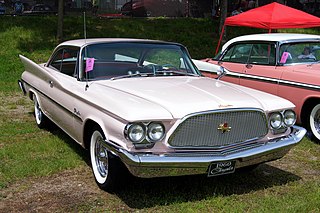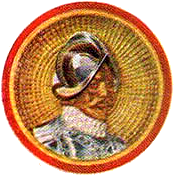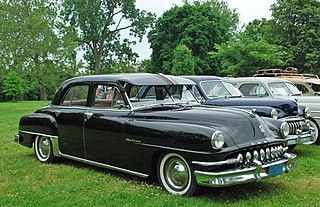
The Chrysler New Yorker is an automobile model produced by Chrysler from 1940 until 1996, serving for several decades as either the brand's flagship model or as a junior sedan to the Chrysler Imperial, the latter during the years in which the Imperial name was used within the Chrysler lineup rather than as a standalone brand.

The Chrysler Royal was a full-size car produced by the Chrysler Corporation in the United States. It was first released in 1933 and continued being built until 1934. Then, the model ended production and did not return until 1937, and then continued until 1950.

The Plymouth Valiant is an automobile which was marketed by the Plymouth division of the Chrysler Corporation in the United States from the model years of 1960 through 1976. It was created to give the company an entry in the compact car market emerging in the late 1950s. The Valiant was also built and marketed, without the Plymouth brand, worldwide in countries including Argentina, Australia, Brazil, Canada, Finland, Mexico, New Zealand, South Africa, Sweden and Switzerland, as well as other countries in South America and Western Europe. It became well known for its excellent durability and reliability, and was one of Chrysler's best-selling automobiles during the 1960s and 1970s, helping to keep the company solvent during an economic downturn.

The Dodge Dart is a line of large passenger cars produced by Dodge from the 1959 to 1976 model years in North America, with production extended to later years in various other markets.

The Chrysler Imperial, introduced in 1926, was Chrysler's top-of-the-line vehicle for much of its history. Models were produced with the Chrysler name until 1954, after which it became a standalone brand; and again from 1990 to 1993. The company positioned the cars as a prestige marque to rival Cadillac, Continental, Lincoln, Duesenberg, Pierce Arrow, Cord, and Packard. According to Antique Automobile, "The adjective 'imperial' according to Webster's Dictionary means sovereign, supreme, superior or of unusual size or excellence. The word imperial thus justly befits Chrysler's highest priced model."

The Dodge Coronet is an automobile that was marketed by Dodge in seven generations, and shared nameplates with the same bodyshell with varying levels of equipment installed. Introduced as a full-size car in 1949, it was the division's highest trim line and moved to the lowest level starting in 1955 through 1959. The name was reintroduced on intermediate-sized models from the 1965 until 1976 model years. Muscle car versions were available starting in 1965 with the 383 and 426 wedge cu in Chrysler RB engine, followed in 1966 by the powerful 426 cu in Chrysler Hemi. Other performance models included the "Superbee", and featured, the 383 cu in Magnum, among other engine options. The nameplate "coronet" is a type of crown worn by royalty.

The Plymouth Belvedere is a series of American automobile models made by Plymouth from 1954 until 1970.

The Chrysler Saratoga is an automobile built by Chrysler. The nameplate was used from 1939 to 1952 and from 1957 to 1960 in the U.S. market, in Canada through 1965, and in Europe from 1989 to 1995. In the beginning, it was introduced as a sport luxury model, using the Straight Eight engine from the Chrysler New Yorker which was more formal, and the Imperial which had graduated to special order limousine.

The Chrysler Windsor is a full-size car which was built by Chrysler from 1939 through to the 1960s. The final Chrysler Windsor sold in the United States was produced in 1961, but production in Canada continued until 1966. The Canadian 1961 to 1966 Windsor model was for all intents and purposes the equivalent of the Chrysler Newport in the United States.

The Dodge Kingsway is an automobile built by Dodge for export markets. The Kingsway name was adopted for the 1940 models. Before that, the export models based on Plymouth models had no unique model names.

DeSoto was an American automobile marque that was manufactured and marketed by the DeSoto division of Chrysler Corporation from 1928 to the 1961 model year. More than two million passenger cars and trucks bore the DeSoto brand in North American markets during its existence.

The Chrysler Town & Country is an automobile which was manufactured by Chrysler from 1940 to 1942 and from 1945 to 1988 with production interrupted during World War II. Primarily produced as a luxury station wagon, the Town & Country was also available in "woodie" four-door sedan, two-door hardtop and convertible body styles from 1947 to 1950, 1968 to 1969 and from 1983 to 1986. The 1988 model year was the last for the station wagon until the 1990 model year when Chrysler reintroduced the Town & Country nameplate as the rebadged variant Chrysler Town & Country minivan.

The DeSoto Six was first introduced in 1929 and was badge engineered from the 1929 Chrysler Six Series 62 with the same 109.75 in (2,788 mm) wheelbase, while it offered a smaller 174.9 cu in (2.9 L) Chrysler I6 with an overall length of 169 in (4,293 mm). It was offered in four two-door sedan configurations and three four-door sedan body styles. It used the Series K designation for two years then was updated to the Series CK in mid-1930.

The DeSoto Series S-10 is an automobile produced by DeSoto from 1942 through to the 1952 model year. While in production, the Series S-10, which was sold with the trim package DeLuxe, was DeSoto's entry-level car, and was offered primarily as two-door and four-door sedans while the Custom offered upscale interiors and appearance including a 7-passenger sedan and the extended-wheelbase Suburban sedans. The body was claimed to be "rust proofed".

The DeSoto Suburban is an automobile produced by DeSoto from 1946 through the 1954 model year. The Suburban was a continuation of DeSoto's long-wheelbase models, first introduced in 1946.

The Packard Patrician is an automobile which was built by the Packard Motor Car Company of Detroit, Michigan, from model years 1951 through 1956. During its six years in production, the Patrician was built in Packard's Detroit facilities on East Grand Boulevard. The word "patrician" is Latin for a ruling class in Ancient Rome. It was the last "senior level" Packard until production ended in 1958.

The Packard 300 is an automobile built and sold by the Packard Motor Car Company of Detroit, Michigan for model years 1951 and 1952. The 300 represented the upper mid-range Packard model and provided better appointments than the Packard 200 or the Packard 250 models, and replaced the Packard Super Eight. The Packard Patrician 400 became the top level "senior" Packard replacing the Custom Super Eight. The 300 was positioned against the Buick Roadmaster, Cadillac Series 61, Chrysler Saratoga, Frazier Manhattan and Lincoln Cosmopolitan.

The Hudson Wasp is an automobile built and marketed by the Hudson Motor Car Company of Detroit, Michigan, from the 1952 through the 1956 model years. After Hudson merged with Nash Motors, the Wasp was then built by American Motors Corporation in Kenosha, Wisconsin, and marketed under its Hudson marque for model years 1955 and 1956.

The Dodge Custom is a full-size car which was produced by Dodge in the United States from 1946 to early 1949, and was also called the DeLuxe in a more basic trim package. Dodge was very fluid with model nameplates and during the 1930s updated them yearly based on marketing objectives, while the actual vehicle was largely unchanged for what became known as the "Senior Dodge's" that were available with shorter "Junior Dodges" that were essentially badge engineered Plymouth models during this time period.

The Chrysler Six was a series of cars that were all installed with the Chrysler Straight Six when the company assumed operations of the Maxwell Automobile Company in 1924, and Chalmers Automobile Company in 1926. The Chrysler Six initially consisted of several Models, then Series designations that originally declared the approximate top speed each vehicle was able to consistently maintain, then each series number was incrementally updated every new model year, and each series was offered in several body style choices. The engines were technically advanced for their time and were entered in the 24 Hours of Le Mans for 1925, 1928 and 1929.




















